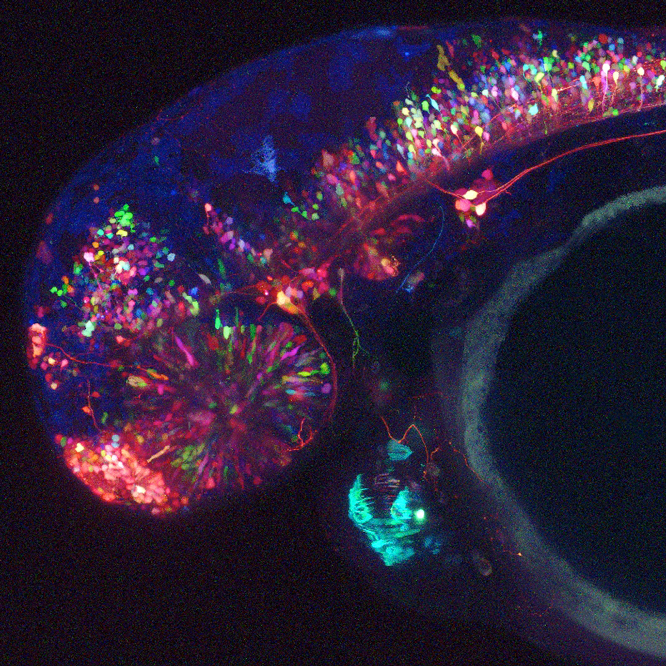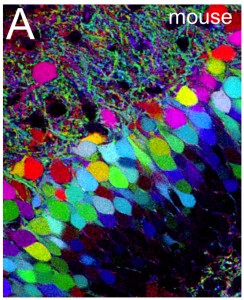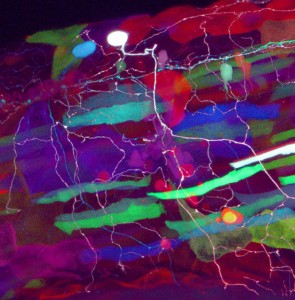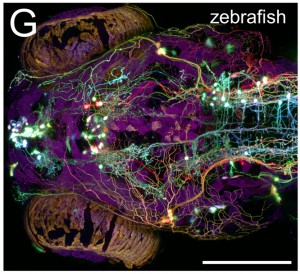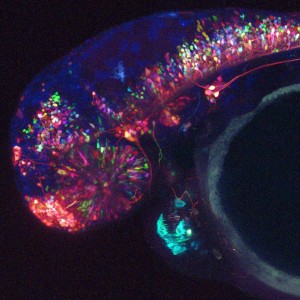Whether your computer screen displays a spreadsheet, a movie, or a LOLcat, you’re seeing pinpoints of light in only three colors: red, green, and blue. But by varying the relative intensity of these three components, a pixel can transform into any one of a spectrum of millions of colors. The same principle lies behind the powerful and visually spectacular Brainbow cell-labeling technique, in which each labeled cell expresses a unique ratio of three or four distinct colors of fluorescent protein. The resulting composite color can distinguish an individual cell from similar cells that surround it.
In the Brainbow approach, different copy-number ratios of each fluorescent protein transgene are achieved by stochastic shuffling of cassettes via site-specific recombinases. Depending on the strategy used, this allows between three and ~100 colors to be differentiated. The method was originally designed to trace the tangled paths of axons through the nervous system, but was rapidly adapted for lineage analyses during development.
The February issue of GENETICS features a Genetic Toolbox Review by Tamily Weissman (Lewis and Clark College) and Albert Pan (Medical College of Georgia, Georgia Regents University) that explores the evolution of Brainbow methods, provides practical tips, summarizes available genetic resources, and reflects on future directions in the field. The authors argue that the technique has opened up entirely new types of research questions because instead of being able to label only different types of cells, now we can use multiple colors within a single cell population. They also anticipate Brainbow’s potential to be combined with new genetic and genomic analyses of cells. Read the Toolbox now for an excellent overview of the field (and of course, some beautiful images!)
CITATION:
Weissman T.A. (2015). Brainbow: New Resources and Emerging Biological Applications for Multicolor Genetic Labeling and Analysis, Genetics, 199 (2) 293-306. DOI: http://dx.doi.org/10.1534/genetics.114.172510, http://www.genetics.org/content/199/2/293.full
- Neurons within the dentate gyrus of the Brainbow mouse hippocampus. Image credit: Tamily Weissman, Jeff Lichtman
- Brainbow expression in a living, 2-day old zebrafish (anterior is to the left). A somatosensory neuron in the spinal cord (light pink) can be seen projecting its fine processes ventrally throughout the trunk. Brainbow can now be used in many different living organisms for distinguishing among individual cells or between clones of dividing cells. Weissman and Pan review of recent findings, improvements, and creative Brainbow applications, including its adaptability to viral approaches and genetic analysis. Image by Zachary Tobias, in the laboratory of Tamily Weissman at Lewis & Clark College.
- Dorsal view of larval zebrafish injected with Brainbow plasmid DNA. Image credit: Albert Pan.
- Head of a living, 2-day old zebrafish. Many tissues are labeled, including the eye, brain, lateral line ganglion, and heart (cyan, which is beating during image capture). Image credit: Zachary Tobias, Tamily Weissman.

